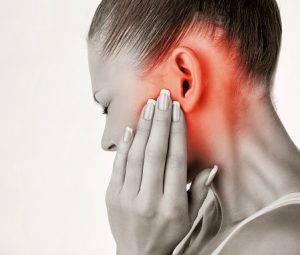 The outer edge of the ear is primarily made up of cartilage, and in some individuals, a sudden sensation of ear cartilage pain may occur. The initial presentation may feel like a pinch or a sharp pain in the outer ear cartilage with not much explanation as to why it occurred in the first place. The external ear consists of tissue, blood vessel, and cartilage, with its main responsibility being a sound receptor for which sound is funneled through the ear canal to the eardrum.
The outer edge of the ear is primarily made up of cartilage, and in some individuals, a sudden sensation of ear cartilage pain may occur. The initial presentation may feel like a pinch or a sharp pain in the outer ear cartilage with not much explanation as to why it occurred in the first place. The external ear consists of tissue, blood vessel, and cartilage, with its main responsibility being a sound receptor for which sound is funneled through the ear canal to the eardrum.
Auricular chondritis: Ear cartilage inflammation
Auricular chondritis is a condition where the cartilage of the ear is inflamed. Inflammation is the process in while immune cells of the body react to what they perceive as a foreign invader. When this occurs in the ear, it can cause it to look inflamed, swollen, red, and feel painful.
Advertisement
The ear itself is primarily composed of a type of springy and supple elastic cartilage, giving us the typical ear shape. Cartilage itself does not have a blood supply running through it like other tissues in the body, and this results in extended healing times needed in order for cartilage to heal appropriately. The perichondrium, soft tissue adjacent to the ear cartilage, provides some of the blood supply. If this source of blood perfusion becomes compromised in any way, the cartilage can die off and shrink.
Signs and symptoms of ear cartilage pain (auricular chondritis)
The presentation of auricular chondritis may vary from case to case, with the following being some possible symptoms:
- Pain and tenderness of the affected area
- Soreness
- Possible fever
- Pus-like discharge
- Aching
- Puffiness
- Red or bluish color
What causes ear cartilage pain?
The causes for inflammation of the ear cartilage can be various. The following are a few probably causes:
- Polychondritis: A rare condition where cartilage in several places over the body, in particular, the ears, nose, and airways of the lungs, become inflamed. The common age of incidence is the 50s and 60s with the cause being relatively unknown. Diagnosis is made using a biopsy.
- Ear piercings: Especially ones through the upper third portion of the ear that go through cartilage and not the earlobe. This may sometimes be referred to as “high” ear piercings. These types of piercings are more susceptible to bacterial infections by pseudomonas aeruginosa or staphylococcus aureus. If left untreated, the formation of a puss filled abscess may develop, resulting in the cartilage to die off.
- Cuts to the ear: Increases the chance of bacterial infection leading to inflammation.
- Trauma to the ear: A direct blow or impact to the external ear may cause significant tissue damage, resulting in the accumulation of blood between the cartilage and perichondrium and subsequent inflammation. The ear may take a cauliflower-like appearance.
- Surgery complication: Procedures such as otoplasty or pinnaplasty that aid in reshaping the ear, or procedures to remove a lesion such as a cholesteatoma, may result in inflammation due to surgical trauma.
- Perichondritis: An infection of the surrounding exterior cartilage. It can be caused by trauma or recent surgery to the ear. Not a direct infection of the cartilage itself, but rather the perichondrium—the thin tissue that envelopes the cartilage providing it essential nutrients.
- Sunburn: Direct trauma from the sun due to prolonged exposure, causing pain.
Ear cartilage pain treatment options
The stage of inflammation or how long an infection has progressed will typically dictate the steps required for ear cartilage pain treatment. The following are some of the most common methods:
- Antibiotics: Commonly prescribed for bacterial infections. Penicillin combined with flucloxacillin may be given, but depending on the type of bacteria, other medications may be better suited.
- Anti-inflammatory medications: Aids in decreasing the swelling and reducing pain.
- Abscess draining: If an abscess is appreciated, it will be necessary to drain it by making an incision. Once drained, stitches may be required to ensure proper healing.
In severe cases where cartilage death has occurred, it will be necessary to remove the dead tissue and cartilage.
Ear cartilage pain relief and prevention tips
While not all causes of auricular chondritis can be prevented—as in cases of unavoidable trauma or suffering from cartilage centric disease—there are some preemptive things one can do to reduce chances of occurrence:
- Avoid placing objects in the ear, this includes cotton balls, your fingers, and sharp objects. If ear wax is an issue, it may be beneficial to get it professionally removed.
- Do not put any unnecessary mechanical pressure on the ears. This may occur by pressing phones, headbands, or headphones directly into the ear.
- Wear ear protection during concerts while cutting the lawn or utilizing loud heavy machinery.
- If you own a bike or motorcycle, make sure the helmet is not too tight fitting around the ears.
- When playing sports, wear the appropriate protective gear to protect the ears from accidental trauma.
